| Articles - Dance/party drugs & clubbing |
Drug Abuse
pilot e: Prevention of Addiction for Young People at Technoparties
A pilot project by the Public Health and Social Services Department of the Canton of Berne and the Contact Foundation Berne
18 August 1998
Introduction by Kurt Jaggi, Head of the Social Services Department of the Canton of Berne
Ladies and Gentlemen
I extend a warm welcome to you on behalf of the Department of Public Health and Social Services. 1 am pleased to be able to present to you in more detail this interesting project, albeit also a delicate one in terms of drug and social policy.
This is already the second media conference on the subject, although we are still not able to inform you about specific results and experience.
There are two reasons in particular why we have nevertheless decided to carry out a second round of information before the first tests.
Firstly, there have been many enquiries from representatives of the media about the progress of the work, the programme dates, and also the test apparatus. We would like to provide answers to these questions today.
Secondly, the intense interest shown by the media puts us in a dilemma. On the one hand we are naturally pleased about the wide media interest, which gives us the opportunity to bring discussion about the drug problem into the public domain. On the other hand, we do unfortunately have misgivings that the presence of the media at parties could make it difficult, perhaps impossible, to carry out the tests, since we are operating in a grey area. Here it is not the conduct of the experts which is questionable, as various criminal law reports quite clearly stress. The difficulty arises rather from the fact that young people who have drugs tested must first obtain these illegally. It is likely that this is also clear to the young people themselves, and therefore it will be difficult to find test subjects if they are afraid of becoming known simply as a result of reports in the media, for example. In making these observations, we are pulled in two directions. We certainly do not wish to dispute your duty to inform. At the same time, we do not want to miss the opportunity of gathering realistic experience with the pilot project. Against this background, we thank you for your restraint and also for your understanding that we shall not announce in advance the dates on which tests are to be carried out.
The demonstration of the test apparatus will probably be at the centre of interest today. Nevertheless, at this point 1 would like to remind you again of the central theme of the project.
We do not only wish to obtain statistical data about drug quality and, where appropriate, to be able to issue specific warnings; our concern takes us further. At the forefront of our interest there remains the question of whether testing Ecstasy at parties provides the opportunity of making contact with young drug-takers. Previous experience in fact clearly shows that the well-known drop-in centres do not allow us to reach young people who certainly are taking drugs, but do not as yet have evident problems as a result.
The actual Ecstasy test, from which we of course also hope to obtain statistical information about the quality of drugs, therefore also provides a setting for the difficult task of making contact with young people.
By offering the test, we want to signal to young people that as a first step we are willing to accept them with their drug-taking habit, and to take them seriously. This will create the foundation for a second step, in whigh we are able to put over our message of prevention just as unmistakably.
The message is:
" The best drug consumption is zero drug consumption. People who nevertheless take drugs should keep the risks as small as possible."
pilot e - Prevention of addiction for young people at technoparties
A pilot project by the Public Health and Social Services Department of the Canton of Berne and the Contact Berne Foundation
The Contact Berne Foundation, in collaboration with the Public Health and Social Services Department of the Canton of Berne, is carrying out the "pilot e" pilot project The primary objective of this one-year project is to keep young people from taking the drug Ecstasy. We provide information about the risks in taking it and provide an advice service. The people who organise the parties should be involved more closely in responsibility for prevention.
With the new raver/party culture which has appeared in Switzerland since the end of the 1980's, the nature of drugtaking by the younger generation has changed. Illegal substances with a performance enhancing and entactogenic effect - among others MDMA (3,4-methylenedioxy-n-methyiamphetamine), its derivatives and amphetamines - have spread in Switzerland, particularly among those who frequent the technoscene. The health risks involved in taking MDMA are the subject of dispute among the experts. It has been shown that taking large doses can trigger acute, lifethreatening symptoms of poisoning, and regular consumption of so-called recreational drugs can lead to psychological dependence and thus to related problems in daily life. Information and explanation about the risks of taking these drugs are therefore a central task in prevention. Among the various possibilities for bringing prevention messages and information directly to the young generation, pilot e has chosen an approach orientated towards acceptance.
pilot e: proposal and tasks
· By providing an information stand and advisers, the pilot project intends to make contact with young people directly at technoparties/raves, in order to talk to them about their consumption of drugs.
· At the "pilot e" information stand, flyers and leaflets about the risks of taking illegal drugs are available to interested partygoers. Where possible, counselling at the drug-advice centres is arranged and started.
. Substance testing: consumers can have their pills analysed on the spot. By means of the substance test, qualitative and quantitative statements about the content of the pills can be made. In this way a basis for a critical examination of the consumption of illegal substances is created. In the accompanying discussion with the adviser, strategies for minimising consumption risks, for giving up drugs, and the prevention message that all drug-taking carries some risk, is communicated to the potential consumers.
· The recording and chemical analysis of the substances provides an insight into the illegal market and makes possible early recognition of new designer drugs and trends in consumption on the party scene.
· Interviews with MDMA consumers using questionnaires provide information on trends in drug-taking behaviour among partygoers.
. Party organisers are informed of the risks and involved more closely in the problem of drug-taking at the events.
Initial experience
During the period from September 1998 to February 1999 pilot e was present at nine events in the Canton of Berne. Altogether 57 substances were tested on site. The information stand with information material and the offer of advice arouses great interest among the party-goers. An average of some 20-25 people took advantage of brief discussions on each occasion. Young people's knowledge of recreational drugs varies greatly. Many of them judge the substances by their effect, not according to the risks in taking them and their side effects. Information about the pills in circulation is mostly obtained from friends and acquaintances. Many of those who take MDMA have little knowledge of how the substance works, which encourages excessive consumption, harmful to health. The majority certainly take some precautions to minimise the risks (adequate liquid intake, taking breaks from dancing), but other essential measures to minimise the risk, such as avoiding taking a mixture of drugs, are not practised by the majority. Most partygoers who take drugs every week consider that their consumption causes no problems.
Trends in consumption
The information about partygoers' consumption habits comes from asking questions on site. Up to February 1999, 47 interviews had been done among the potential consumers who had a substance test carried out by "pilot e".
Average age: The average age of those questioned is 21 years (median). 50% of those questioned are between 20 and 26 years old (n=44).
Age at the time "Ecstasy" was first taken:
The average age (median) at the time of first use is 17.5 years. The lowest age at the time of first use is
12 years. The age at first use lies between 16 and 22 years for 50% of those questioned. (n=44)
Average consumption of Ecstasy: Average consumption of Ecstasy in the 4 weeks prior to the time of questioning. 45% of those questioned had taken at least one pill per week. (n=44)
Total consumption of Ecstasy:
The subject's own estimate of the total number of pills taken.
66% of those questioned have taken more than 50 pills in their life. (n=44)
Consumption together with amphetamine:
34% of those questioned usually or always take amphetamine at the same time as Ecstasy. (n=44)
Consumption together with cannabis:
58% of those questioned usually or always take cannabis at the same time as Ecstasy. (n=43)
For advice and on-site testing you can contact us at:
Mr. Hans Pauli, Beratungsstelle Contact Bern (Contact Berne Advice Centre), Tel. 031 378 22 22 /email:
This e-mail address is being protected from spambots. You need JavaScript enabled to view it
Mr. Daniel Allemann, Pharmazeutisches Kontrolliabor (Pharmaceutical Test Laboratory), Tel. 031 308 80 12
Further press information may be obtained from:
Ms. Ruth Gaby Vermot, Foundation President, Tel. 031 382 16 30
Mr. Jakob Huber, Manager, Tel. 031 378 22 44
Stiftung Contact Bern (Contact Berne Foundation), March 99
Ecstasy pilot project: description of the test procedure and apparatus
Daniel Allemann
Chemical-analysis requirements
Chemical analysis of an Ecstasy tablet gives one of three possible results. The findings may be a single active agent, several active agents, or indeed no active agent. Reliable analysis of the substances in it cannot be achieved by means of a simple "quick test", and is only possible by the use of a complex measurement chain, as shown in the following basic diagram:

Analysis sequence
In the pilot project we are using a (mobile) high-performance liquid chromatograph, usually abbreviated to HPLC (chromatography is the technical term used for this separation process. The central element of the HPLC apparatus is the separating column. This serves to separate mixtures of substances. HPLC column-chromatography is a special form of liquid chromatography. The separating mechanism at work in liquid chromatography is most easily explained by the example of classic glass-column chromatography.
The separation process:
Initial phase: The mixture of components @ and & is fed into the chromatography column, which is placed vertically. A continuous flow of solvent passes through the column (at atmospheric pressure, under gravity). The components interact with the solvent and the porous filling material.
Separation phase: Because of their dissimilar chemical structures, the behaviour of the two components on the column is different:
@ is bound more strongly to the solvent, & is bound more strongly to the filling material.
Since fresh solvent continues to pass through, @ migrates through the column more quickly than &.
Final phase: The A component leaves the column as a pure substance & continues to migrate in the filling material. As soon as @ has also left the column, the separation procedure is completed and the supply of solvent can be cut off. The time taken by an active substance to pass through the separation system is defined as the retention time. Under identical separation conditions the retention time of a substance is always the same and is therefore a characteristic constant for the substance.
HPLC: High-performance liquid chromatograph
The pilot project requires a short analysis time. With classical column chromatography a separation would take hours. Moreover the separating capacity of the filling used is inadequate. Performance can be improved by:
reducing the grain size of the filling material (from 200um to 3um)
using a high-pressure feed-pump to circulate the solvent (operating pressure up to 200 bar)
using at least two different solvents during the separation process.
The very small grain size gives dense filling of the column (with increased separating capacity). This very dense filling then requires a high pressure to make the liquid pass through it quickly (about 1 min). Accurate mixing of solvents during separation can only be achieved by the use of special pumps. By varying the solvent composition the analysis time can be reduced still further. The pump ensures constant separation conditions. Because of the high pressure, we use a stainless steel HPLC column. This is 12.5 cm long, has an internal diameter of 4 mm and a grain size of 3 lim. Separation takes place in about 15 minutes
The detector
A chemical detector records molecules and measures their concentration. It forms the "eye" of the measurement chain. In our system we use a UV-detector. This records substances which absorb ultraviolet light. Its measurement cell is positioned at the end of the column, and a stream of solvent passes through it. This highly sensitive detector provides two kinds of information about the molecules measured: their identity and their quantity. The detector continues to measure throughout the whole separation process. At the same time the computer linked to it converts the measurement signals into usable graphical displays, these appearing on the screen at the rate of one every second. We are thus able to follow the progress of the analysis directly. The two most important displays are the chromatogram and the UV-spectrum. The chromatogram is a representation of the separation process, and the UV spectrum a display of the active substance found. The UV-spectrum is a characteristic constant for a particular substance.
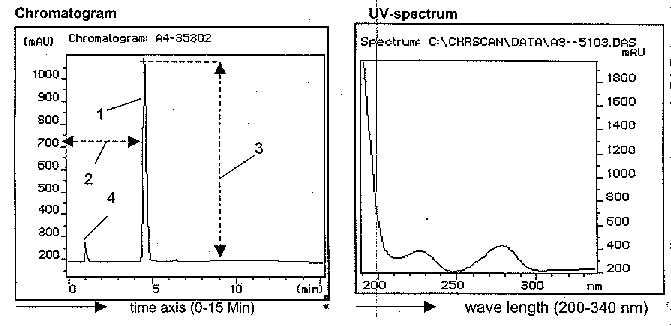
1 peak (signal from a component)
2 retention time of the component
3 height of peak
4 small peak (contamination)
Analysis:
Qualitative analysis:
The number of peaks indicates the number of active agents. c> The substance characteristic constants, retention-time of a peak and associated UV-spectrum, provide information about the identity of the active agent.
Quantitative analysis:
The height (or area) of a peak serves for quantitative analysis. These data provide important indications concerning the dosage of the active substances in an Ecstasy tablet.
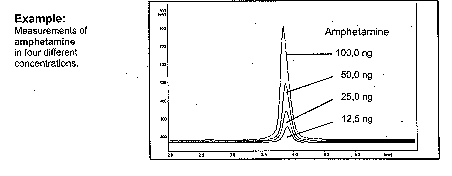
Other features:
Sample preparation:
The material to be tested is pulverised in a mortar, dissolved in methanol and diluted. In most cases this extract still contains insoluble components, which must be filtered off before analysis. The clear sample solution obtained in this way is transferred to a sample bottle.
The sample dispenser
The function of this device is to transfer the prepared tablet extract from the test flask to the separating column without loss. The volume injected is only 1 /100 m]. Precise work with such small sample quantities requires a very accurate injection device.
The mobile high-performance liquid chromatoqraph
An important feature of the pilot project is on-site analysis. Since we take the view that even an analysis of this type should only be performed using a sound method, we decided to develop a mobile highperformance liquid chromatograph especially for the project. A HPLCsystem plus the associated samplepreparation facilities normally takes up the floor area of half a laboratory. We have reduced the complete system to a floor area of 65 x 130 cm.
Outline drawing: layout of the mobile high-performance liquid chromatograph

Design and construction: Daniel Allernann
Key.
Sample-preparation section (1) Data storage (Jaz-Drive) (13)
Ultrasonic bath (2) Compressed-air bottle (Autosampler) (14)
Solvent waste funnel (3) Detector (15)
Clamps (4) Autosampler (with column heater) (16)
Solvent bottles (5) Chromatography column (in column heater) (17)
Protective tank (6) Solvent waste pipe (18)
Protective screen (7) Solvent waste can (19)
De-gassing unit (8) Accessories drawer-unit (20)
Control system interface (9) Power distribution board (21)
Computer (notebook) (10) Printer (22)
Thermometer (11) 220 V power-supply cable (23)
HPLC-pump (12)
For further technical information: Daniel Allemann Kantonsapothekeramt
Pharmazeutisches Kontroll-Labor (Pharmaceutical Control Laboratory)
Tiefenaustrasse 120 3004 Bern
Tel. 031 308 80 12 Fax 031 308 80 28
E-Mail:
This e-mail address is being protected from spambots. You need JavaScript enabled to view it
5
On-site chemical Analysis
The test procedure used in the Pilot e project combines the two requirements of quality and mobility
Quality: In the best case scenario, the HPLC (high-performance liquid chromatography) measurement technique will yield two important results within 20 minutes:
1. Which psychoactive substances are present in the sample material, and
2. How high the concentrations of active substances are which are found in the sample.
Mobility: Normally analyses of this quality can only be carried out in the laboratory. Our prototype, however, is a "compressed" laboratory on wheels, the convenience of which allows the latest measurement data to be inserted in the prevention message as early as possible.
Flow diagram for the Ecstasy monitoring procedure
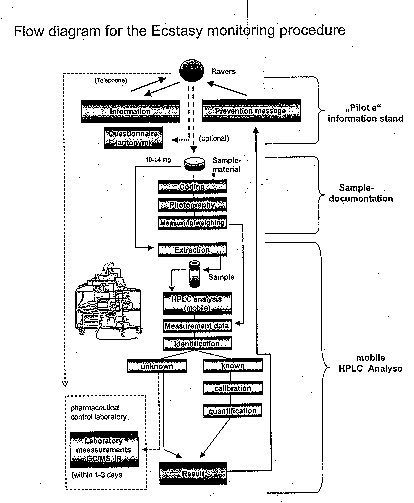
Diagrams
Number of Samples: n = 86
57 analyses were carried out at technoparties
29 analyses were carried out in the laboratory, using the mobile equipment. These samples were sent directly to the (Kantonsapothekeramt) cantonal pharmacist's office.
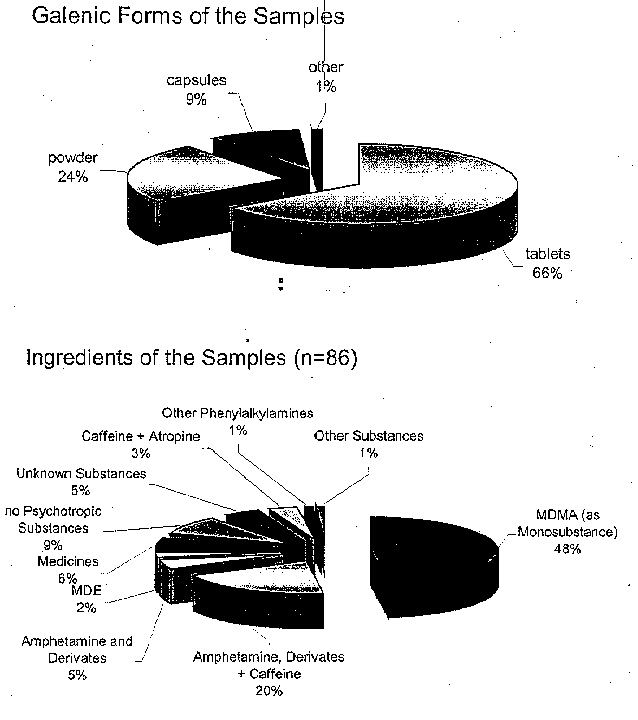
Quantification
We make quantitative measurements of the current main active substances: MDMA, MDA, MDE, methamphetamine, amphetamine, ephedrine, norephedrine and caffeine. If a new substance appears on the market, we can incorporate this into the measurement method, provided that we have access to the pure reference substance.
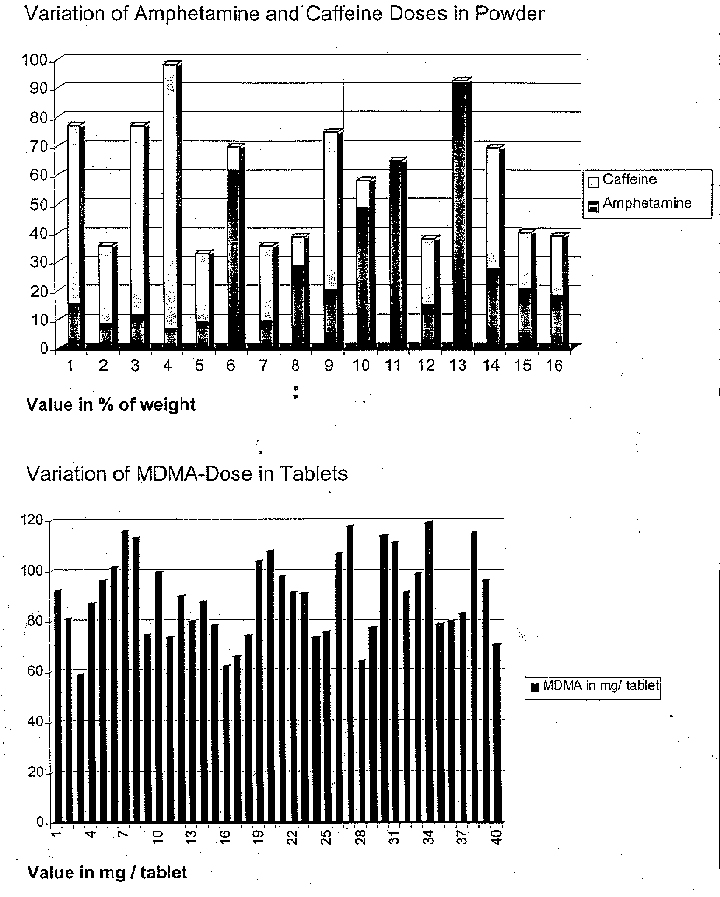
" The best drug consumption is zero drug consumption. People who nevertheless take drugs should keep the risks as small as possible."












